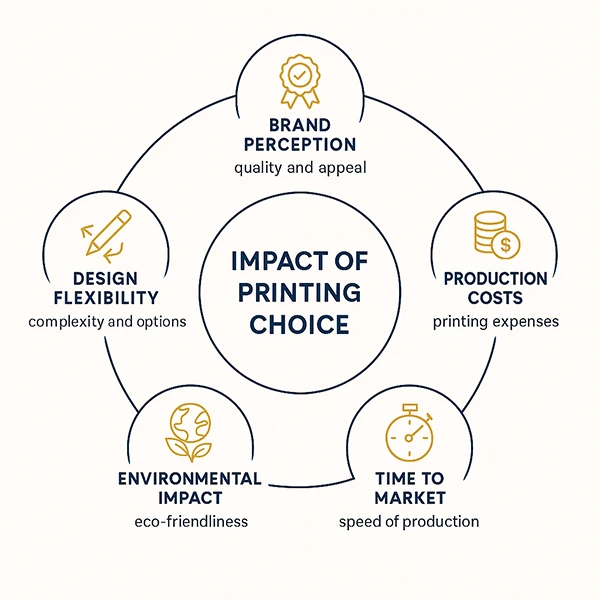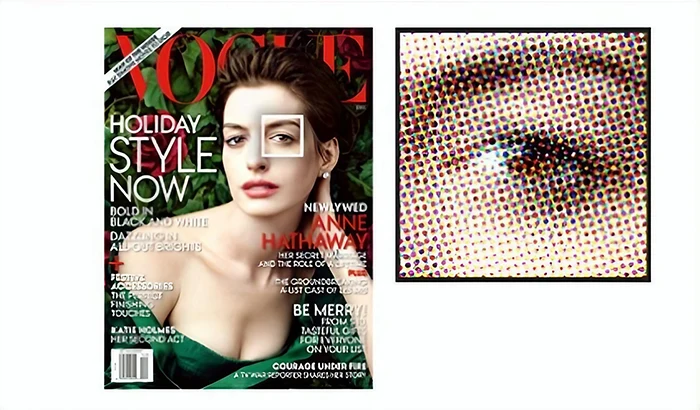Your product box is often the first physical touchpoint between your brand and your customers. In fact, studies show that over 70% of consumers say packaging design influences their purchase decisions. Yet many businesses struggle with a fundamental question: which printing technique will bring their packaging vision to life while staying within budget?
Whether you’re launching a new beauty brand, shipping electronics, or creating luxury gift boxes, the printing method you choose can make or break your packaging’s impact. The wrong choice might leave you with washed-out colors, blurry logos, or worse—a bill that blows your budget.
This guide demystifies the world of packaging printing methods, from flexographic to digital printing and everything in between. You’ll discover which technique suits your specific needs, helping you balance quality, cost, and sustainability for your custom product boxes.
Why Your Printing Technique Matters
Choosing the right printing technique isn’t just about how the box looks—it influences cost, speed, sustainability, and more.

- Brand perception: A crisp, vibrant print signals quality, while poor printing can make even premium products look cheap
- Production costs: The same design can vary dramatically in price depending on the printing method
- Time to market: Some techniques require weeks of setup, while others can deliver boxes in days
- Environmental impact: Different methods use varying amounts of energy, materials, and produce different levels of waste
- Design flexibility: Not all printing techniques can handle complex graphics or multiple design variations
Consider this: printing a luxury candle box with photographic imagery requires a completely different approach than producing 10,000 simple shipping boxes with a one-color logo. Understanding these differences helps you make informed decisions that align with your brand goals and budget constraints.
Overview of Packaging Printing Methods
Let’s explore the most common printing techniques for product boxes, examining the pros and cons of each to help you make the best choice for your packaging project.
Flexographic Printing (Flexo)
Flexographic printing uses flexible relief plates and fast-drying inks to transfer images directly onto packaging materials. Think of it as a modern, high-speed version of a rubber stamp. This method dominates the corrugated box industry—those brown Amazon shipping boxes arriving at your door? They’re typically printed using flexo.
When flexo is ideal:
- Large volume orders (5,000+ boxes)
- Simple designs with 1-3 colors
- Bold graphics and text
- Printing on corrugated cardboard or kraft paper
- When you need fast turnaround and low cost per unit
When to avoid flexo:
- Photographic images or fine details
- Small batch orders (under 1,000 units)
- Designs requiring precise color matching
- Projects needing multiple design variations
The main advantage of flexographic printing lies in its efficiency at scale. Once the plates are made, you can print millions of boxes quickly and affordably. However, each color requires a separate plate, and the technology struggles with gradients or photorealistic images—you might notice banding or loss of fine detail.
Offset Lithography Printing
Offset lithography represents the gold standard for high-quality packaging printing. This method uses etched metal plates to transfer ink onto a rubber blanket, which then “offsets” the image onto your packaging material. It’s the same technology used to print magazines and high-end marketing materials.

Offset printing excels when you need:
- Magazine-quality graphics and photos
- Precise Pantone color matching
- Large runs of premium packaging (cosmetics, electronics, luxury goods)
- Consistent color across thousands of units
- Sharp text and intricate patterns
Limitations of offset printing:
- High setup costs due to plate creation
- Not economical for runs under 1,000-2,000 units
- Longer lead times (7-14 days typical)
- Limited to flat sheets (requires lamination for corrugated)
Premium brands often choose offset printing because it delivers unmatched print quality. Those stunning cosmetic boxes with perfect skin tones and vibrant colors? That’s offset lithography at work. The investment in plates pays off through superior results and lower per-unit costs at higher volumes.
Digital Printing
Digital printing has revolutionized short-run packaging by eliminating plates entirely. Like an industrial-sized version of your office printer, it transfers designs directly from computer files to packaging materials. This technology has improved dramatically, now rivaling traditional methods for quality while offering unprecedented flexibility.
Digital printing is perfect for:
- Short runs (1-500 boxes)
- Prototypes and market testing
- Personalized or variable data packaging
- Seasonal or limited-edition designs
- Quick turnaround projects (as fast as 24-48 hours)
- Multiple SKUs with different designs
Digital printing challenges:
- Higher per-unit cost for large volumes
- Slight color variations between runs
- Limited material compatibility
- Pantone matching can be tricky
The beauty of digital printing lies in its flexibility. Need 100 subscription boxes, each with a customer’s name? Digital makes it possible. Want to test three package designs before committing to thousands? Digital printing lets you experiment affordably. As one packaging expert notes, “Each printing method has its own features, benefits, and requirements—and each creates a solution that suits different types of businesses and their budgets.”
Other Methods: Gravure & Screen Printing
While less common for standard product boxes, these specialized techniques serve specific packaging needs:
Rotogravure (Gravure) Printing
- Uses engraved cylinders for ultra-high volume runs (millions of units)
- Delivers exceptional consistency and quality
- Common for flexible packaging (think potato chip bags)
- Requires massive setup investment—only viable for huge brands
Screen Printing (Silkscreen)
- Pushes ink through mesh stencils
- Creates vibrant, opaque colors on dark surfaces
- Ideal for special effects or unique materials
- Perfect for small batches of specialty boxes
- Often used to add white ink on black boxes where other methods struggle
These methods occupy niche positions in packaging. Gravure might print millions of cigarette packs, while screen printing could add a striking UV spot varnish to 200 limited-edition perfume boxes.
Comparing the Printing Methods – Which Should You Choose?
Now comes the crucial question: which printing technique suits your specific project? Let’s break down the decision by key factors:
Cost & Volume Considerations
For quantities under 500 boxes:
- Digital printing typically offers the lowest total cost
- No plate fees mean affordable entry
- Perfect for startups and test runs
For 500-5,000 boxes:
- Compare digital vs. offset carefully
- Calculate plate costs against per-unit savings
- Consider flexo for simple designs
For 5,000+ boxes:
- Offset or flexo become significantly more economical
- Plate costs spread across large runs
- Digital becomes prohibitively expensive
Remember: setup costs for offset and flexo (plates, proofing) can run $100-1,000+, but unit costs drop dramatically at scale.
Print Quality & Design Complexity
For photographic images or intricate details:
- Offset lithography delivers the highest quality
- Digital printing offers excellent results for short runs
- Avoid flexo unless design is simplified
For bold, simple graphics:
- Flexo provides crisp results at low cost
- All methods work well
- Choose based on volume and budget
For exact Pantone matching:
- Offset and flexo excel with spot colors
- Digital uses CMYK process (close but not exact)
- Critical for brand consistency
Material & Box Type
Corrugated shipping boxes:
- Flexo prints directly on brown kraft
- Digital works for short runs
- Offset requires litho-lamination (expensive but high-quality)
Folding cartons (smooth paperboard):
- All methods work well
- Choose based on volume and design
- Offset dominates retail packaging
Special materials or finishes:
- Screen printing handles unusual surfaces
- Combine methods (offset + hot stamping for metallic effects)
- Consult your printer for compatibility
Speed & Flexibility
Need boxes in days?
- Digital printing offers fastest turnaround
- No plates or lengthy setup
- Some providers offer 24-hour service
Planning multiple versions?
- Digital excels at variation (different designs, personalization)
- Offset/flexo require new plates for each version
- Consider hybrid approach for base design + variable elements
Standard lead times:
- Digital: 2-5 days
- Flexo: 7-10 days
- Offset: 10-14 days
Sustainability Factors
Environmental consciousness increasingly drives packaging decisions, with 70% of consumers choosing products based on packaging sustainability. Here’s how printing methods compare:
Most eco-friendly options:
- Modern flexo with water-based inks
- Digital printing (minimal waste, print-on-demand reduces overstock)
- UV-cured inks (no solvents)
Considerations for each method:
- Flexo: Ask about water-based or UV inks to reduce VOC emissions
- Offset: Request vegetable-based inks; note higher setup waste
- Digital: Eliminates plate waste but uses more energy per unit
Sustainability best practices:
- Choose methods that minimize overproduction
- Opt for water-based or vegetable inks
- Consider print-on-demand for seasonal items
- Ask suppliers about recycling programs
Making Your Decision: A Quick Guide
Choose Digital Printing if:
- You need under 500 units
- Design includes photos or complex graphics
- Quick turnaround is critical
- You want to test multiple designs
- Personalization is required
Choose Offset Printing if:
- You need 2,000+ units with premium quality
- Brand colors must match perfectly
- Design includes fine details or gradients
- Budget allows for setup investment
- Consistency across large runs is crucial
Choose Flexographic Printing if:
- You need 5,000+ simple boxes
- Design uses 1-3 bold colors
- Printing on corrugated or kraft
- Cost-per-unit is the priority
- Standard shipping boxes are the goal
Consider Specialty Methods if:
- Volume exceeds 1 million units (gravure)
- You need special effects or unique materials (screen)
- Standard methods can’t achieve your vision
Industry Trends Shaping Printing Decisions
The packaging printing landscape continues to evolve rapidly. Digital printing grows at 9% annually, driven by e-commerce and personalization demands. Brands increasingly use variable data printing to create unique customer experiences—imagine opening a subscription box with your name seamlessly integrated into the design.
Flexographic printing has also advanced significantly. Modern flexo presses achieve higher resolution and better registration, narrowing the quality gap with offset. Some innovative suppliers now offer hybrid approaches, like litho-lamination, combining offset’s quality with corrugated’s durability.
Sustainability drives innovation across all methods. Water-based inks, energy-efficient equipment, and waste reduction programs are becoming standard. Forward-thinking brands choose printing methods that align with their environmental commitments while maintaining quality.
Conclusion
Choosing the right printing technique for your product box isn’t about finding the “best” method—it’s about matching your specific needs with the appropriate technology. Your perfect solution depends on your unique combination of quantity, quality requirements, budget, timeline, and sustainability goals.
Start by honestly assessing your priorities. Are you launching a new product and need 200 test boxes quickly? Digital printing is your answer. Planning to ship 50,000 boxes with your logo? Flexographic printing will maximize your budget. Creating premium packaging that must wow customers on retail shelves? Offset lithography delivers the quality you need.
Remember to consider future needs too. That digital printer perfect for your startup phase might become costly as you scale. Building relationships with suppliers who offer multiple printing methods provides flexibility as your business grows.
Still feeling overwhelmed by the options? You’re not alone. Packaging printing involves numerous technical considerations, and the stakes—your brand’s presentation—are high. That’s where expert guidance becomes invaluable.
At BrillPack, we understand that every packaging project is unique. Our experts guide you through these printing options, helping you balance quality, cost, and sustainability.
Ready to bring your packaging vision to life? Contact our team to discuss your project, or explore more resources in our Packaging Academy. Let’s create packaging that not only protects your product but elevates your brand—printed using the technique that makes the most sense for you.
Contact for a Free Consultation!

